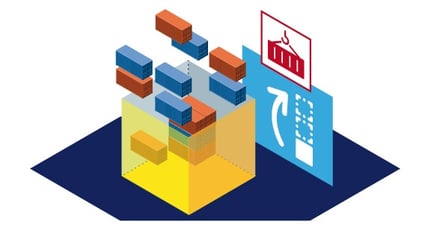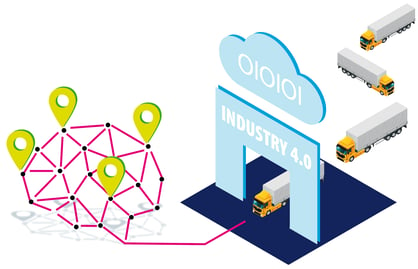Will Logistics 4.0 Lead to Intelligent Supply Chains?
Jesse Kelber - August 01, 2019

 Logistics 4.0 is an offshoot of the larger trend in manufacturing known as Industry 4.0. Think of it as being to the supply chain what Industry 4.0 is to the factory, and you’ll begin to see the potential for massive disruption (of the good kind). As such, there is considerable overlap in the technologies at play. For example, the same IoT sensors that are revolutionizing preventative maintenance on the production line are also revolutionizing how the purchasing department determines what supplies to order. And the ability to automate production processes is being mirrored in the way those orders are being placed and the shipments themselves are being handled when they arrive. With the arrival of smart pallets, shelves, trucks, containers—even entire warehouses—logistics providers are able to create complete transparency up and down the value chain.
Logistics 4.0 is an offshoot of the larger trend in manufacturing known as Industry 4.0. Think of it as being to the supply chain what Industry 4.0 is to the factory, and you’ll begin to see the potential for massive disruption (of the good kind). As such, there is considerable overlap in the technologies at play. For example, the same IoT sensors that are revolutionizing preventative maintenance on the production line are also revolutionizing how the purchasing department determines what supplies to order. And the ability to automate production processes is being mirrored in the way those orders are being placed and the shipments themselves are being handled when they arrive. With the arrival of smart pallets, shelves, trucks, containers—even entire warehouses—logistics providers are able to create complete transparency up and down the value chain.
Connected Vehicles: Step One Toward an Intelligent Supply Chain
Autonomous vehicles make the news fairly often these days, and you would be justified in wondering what they mean for the logistics world. Well, the first thing to know is that we’re not really up to the autonomous vehicle stage just yet. What we do have available is darn close to it, however: Trucks that can decide on the best route from all available options based on traffic flow predictions, weather conditions, and even fuel costs; smart pallets that can sense everything from tilt angle to temperature and environmental conditions and send real-time reports; and smart containers that can monitor and report on their own environmental conditions, then make necessary adjustments to ensure the well-being of their cargo.
And the interconnected data flow continues between the trucks and the warehouses. IoT sensors and RFID tags combine to offer powerful monitoring solutions for the flow of supplies, inventory control, and shelf usage and load balancing. When a smart truck is on approach, it can notify the warehouse of what cargo it’s carrying, and the warehouse can send the word to the pallet jacks and warehouse staff so that adjustments can be made, freeing up space in the right section for the supplies as they arrive. Then, when the finished product is ready, the warehouse and outbound trucks can communicate the space and environmental conditions required to ensure the finished product arrives on time and in peak shape.
Logistics 4.0: More Than Just Shipping
These tectonic shifts in technology are impacting more than just the shipping and receiving side of the supply chain. Purchasing is seeing benefits in the form of automated reordering, invoicing, and payments, all of which can streamline even the most complex vendor scenarios. Then consider the impact advanced analytics is having in the form of artificial intelligence and machine learning taking over the back end calculations. And finally add in the IoT sensors being used to monitor stock levels in real-time and you see how these technologies interact and support one another. And at the same time, you start to also see how these technologies can be deployed in stages, with each new piece enhancing the last and adding to the existing functionality. All of this is leading us toward the ultimate goal—the intelligent supply chain.
In the intelligent supply chain, several things will be possible. Supply orders will be automated to go out whenever levels drop below a predetermined point. Inventory will be adjusted, automatically, based on the decisions of the AI running the equipment involved. And ultimately, predictive delivery is not outside the realm of possibility. That describes a situation where warehouses are a thing of the past and orders are fulfilled as the product is produced, going directly from the manufacturing facility onto the trucks and off to the customer. Without the need for inventory storage, the cost savings will be enormous, not to mention the cost savings related to autonomous delivery methods. All of that said, there are stumbling points that will need to be overcome before many aspects of the intelligent supply chain can be realized.
The Future is Not Without its Hurdles
Let’s start with the delays in autonomous vehicles: As the technology stands today, we have trucks that can decide what route is optimal, but the driving is still done by a human. There is also a persistent reliance on pen, paper, and clipboard in the logistics and planning world. Even where there have been advancements made, they often stop with the use of Excel in place of the paper and clipboard. This situation is exacerbated by the also persistent “I’ve been doing this for 30 years, why should I change?” attitude on the part of many planners. And finally, there are concerns about data security in the age of connected devices sending customer information along with proprietary company information over the internet.
And even once these hurdles are surpassed, there is the fact that many of these technologies are still in an emergent state. That means there’s still a fair bit of maturing necessary before mass adoption can take place. Trucks that can drive themselves are being worked on, but are not available as of yet. For now, we’ll have to make do with the truck making suggestions and a human having the final decision making power. Smart pallets do exist and can report on conditions, but they can not yet make the final call or adjust those conditions autonomously. And warehouse sensors can and do detect supply levels and are capable of triggering an alert to purchasing, but they cannot yet place the actual resupply order.
All told, progress is definitely being made, and fast. Logistics 4.0 represents a sea-change in the management of the global supply chain, one on par with what’s being seen in the factories of the world thanks to Industry 4.0. The emerging technologies that form the backbone of these changes have the power to affect the entire value chain, from end to end. Suppliers, warehouses, and shipping are all set to reap huge rewards by undergoing their own digital transformation. That said, they are not quite mature enough to allow for the fully autonomous supply chain. Yet. That time is on the horizon and these are the technologies that will make it a reality.
LATEST POSTS
- Understand Circular Economy in The Manufacturing Industry
- How Can Industry 4.0 IT Integration Be Achieved Smoothly?
- The Significance of Order Sequencing in Discrete Manufacturing
- How to improve your Supply Chain Management: The Power of Control Towers
- Optimizing Human Resource Scheduling in Manufacturing: A Technological Approach



